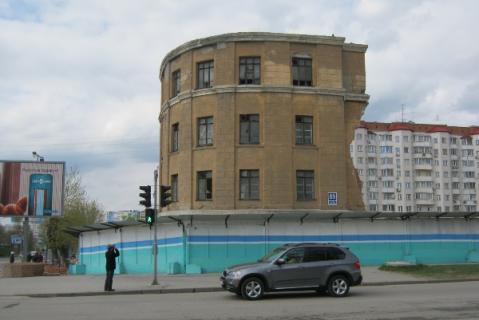Between 1929 and 1951 the NKVD interrogation No. 1 in Novosibirsk was one of the main transit prisons in the USSR. The prison was designed to hold 2,000 inmates but for many years it contained 3-5 times that number. Prisoners were transported from here to the camps of eastern Siberia and Kolyma.
In 1938, according to historian A.G. Teplyakov, a “special section” was organised on the first floor of the building. The cells were turned into offices for the investigators who interrogated prisoners round the clock. Because of the great influx of prisoners up to 100 investigators worked at the prison at one and the same time. After 1951 the regional psychiatric out-patients clinic was housed in the building. It remained there until 2006 after which the building stood empty for six years. In early 2012 the building was demolished, and the territory was sold to a private builder.
The public had repeatedly sent the regional prosecutor’s office requests to examine the possible presence of burials where the building stood. No fundamental examination of their evidence was made. In particular, in July 2012 the Zheleznodorozhny district prosecutor’s office turned down a request for action from A.G. Rudnitsky, chairman of the Novosibirsk Memorial society, claiming that “a visual examination of the construction site did not confirm the existence of burials there”. In May 2013 human remains (seven skulls and 734 fragments of bone) were discovered on the site. They were presumed to date back to the 1930s-1940s. Building work was halted, the remains were confiscated by the investigators and sent for expert examination. The RF Investigative Committee for the Novosibirsk Region did not make any official statement about the results and a criminal investigation was not opened. On 2 August 2013 activists attached a banner to the fence of the construction site which read “People were shot here. The Novosibirsk Transit Prison” (see photo). Within three hours it was removed.
In 2014 RIC Memorial asked the Mayor’s Office about the presence in Novosibirsk of burials of the Victims of Political Repression. “There are no sites of mass burial of the victims of political repression in the public cemeteries of Novosibirsk,” the Mayor’s Office replied on 1 April 2014. “A record of separate places for the interment of citizens recognised as victims of political repression is not envisaged.”
*
Despite public indignation a 22-storey de luxe block of offices and apartments was built there and opened late in August 2016 for purchase or lease.
The Investigative Committee passed the remains discovered in 2013 to A.G. Rudnitsky and for several years he kept the ten bags of bones in his garage. The city administration did not support public suggestions that the remains should be reburied in Narymsky Square, next to the former prison. Instead, the authorities proposed that the bones be cremated and then hold a discussion as to where the ashes were to be laid to rest. In April 2017 the remains were cremated but a location for their honorary burial was not decided. They are being kept in a container by Rudnitsky.
A Book in Remembrance of the Victims of Political Repression in the Novosibirsk Region (4 vols. 2005-2014) contains biographical entries on 12,000 who were shot or sent to the camps.
The Memorial online database (2025) includes 21,735 victims in the Novosibirsk Region.
7,498 were shot (6,855 during the Great Terror). Charges against 443 other individuals were dropped. More than 6,000 were held in the camps: the deaths of almost 300 prisoners are recorded. Families and individuals were deported (total 6,668), the great majority in the early 1930s (5,884).
| State of burials | Area | Boundaries |
|---|---|---|
|
have not survived
|
not determined
|
not delineated
|
Sergei Krasilnikov, “The Chekists shot people without a trial”, NGS Novosti, 22 December 2009
“All Novosibirsk is built on bones”, NGS Novosti, 17 April 2012
“Create museum of repressive measures in the old transit prison building, suggest city activists”, Taiga info, 28 March 2012 [retrieved, 28 May 2022]
“Rebuilding in Novosibirsk will culminate in the demolition of the former prison building on 1905 Street”, Taiga info, 8 May 2012 [retrieved, 28 May 2022]
“The identity of those shot during the 1930s in the transit prison has been established”, Demokrator.ru, 14 May 2013 [retrieved, 28 May 2022]
“The chairman of the Union of the Repressed on the torture and execution in the demolished NKVD prison”, Sibgrad, 4 June 2013
Anton Luchansky, “On the mass burial at the transit prison and the cremation of the remains”
“A placard bearing the names of those shot in the transit prison has been put up in Novosibirsk”, Komsomolskaya pravda, 2 August 2013 [retrieved, 28 May 2022]
Yu. Trigubovich, “State cannibalism must not be forgotten”, Radio Svoboda, 14 August 2017 [retrieved, 28 May 2022]
*
“Novosibirsk. Burial place of those shot in NKVD prison”, Virtual Museum of the Gulag [retrieved, 28 May 2022; no longer accessible]
Reply from the Novosibirsk Mayor’s Office (№ 01/44/01573 of 1 April 2014) to a formal enquiry by RIC Memorial (St Petersburg)



